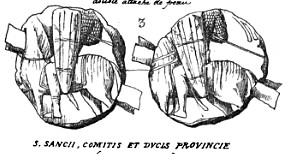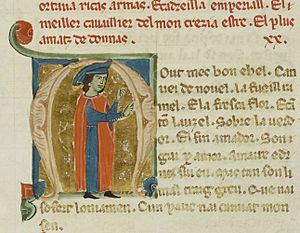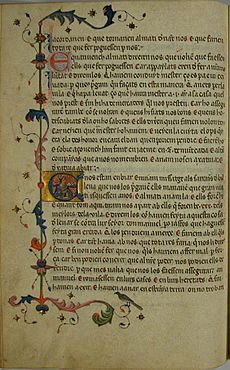Sancho, Count of Provence facts for kids
Quick facts for kids Sancho |
|
|---|---|

Partially preserved seal of Sancho of Provence
|
|
| Count of Provence | |
| Reign | 1181–1185 |
| Predecessor | Ramon Berenguer III |
| Successor | Alfonso II |
| Count of Cerdanya | |
| Reign | 1175–1188 |
| Predecessor | Peter |
| Successor | Nuño Sánchez |
| Count of Roussillon | |
| Reign | 1208–1212 |
| Successor | Nuño Sánchez |
| Died | 1223 |
| Spouse | Ermessenda Sancha Nuñez de Lara |
| Issue | Nuño, Count of Cerdanya |
| House | Barcelona |
| Father | Ramon Berenguer IV, Count of Barcelona |
| Mother | Petronilla of Aragon |
Sancho (died 1223), also known as Sanç or Sanche, was an important nobleman and leader from the Crown of Aragon. He was the youngest son of Queen Petronilla of Aragon and Count Raymond Berengar IV of Barcelona. Sancho held several important titles during his life. He was the count of Cerdanya (around 1175–1188), Provence (1181–1185), and Roussillon (1208–1212). He also served as a temporary ruler, called a regent, for Provence from 1209 to 1218 and for Aragon from 1214 to 1218. He took on these regent roles when the actual counts or kings were too young to rule.
Contents
Sancho's Journey as a Leader
Becoming Count of Cerdanya
Sancho was very young when his father passed away in 1162. He didn't get any lands or titles right away. His father's will said he would only inherit Provence and Cerdanya if his older brothers died without children. He became Count of Provence in 1181 after his older brother, Raymond Berengar III, was killed. It seems he received Cerdanya a little before that.
Sancho grew up and became an adult between 1175 and 1180. During these years, he started signing official documents for his oldest brother, King Alfonso II of Aragon. Sometimes, he used the title "Count of Cerdanya" in these documents. However, King Alfonso didn't fully trust Sancho's rule in Cerdanya. Alfonso stepped in to manage the county in 1177 and again in 1188. After 1188, Sancho was no longer recorded as the Count of Cerdanya.
Ruling Provence
When Sancho became Count of Provence in 1181, he had to defend the area from Raymond V of Toulouse, another powerful count. For four years, Sancho and his brother Alfonso fought against Toulouse. In 1183, Alfonso also gave Sancho control over the counties of Gévaudan, Rodez, and Carlat.
Sancho's time as count in Provence wasn't always smooth. He often had conflicts with William IV of Forcalquier, a neighboring prince. In 1184, Sancho made an agreement with the Count of Forcalquier, the Count of Toulouse, and the city of Genoa. They all agreed to work against the King of Aragon's plans to control Genoa and take the city of Marseille. Sancho even helped Genoa in its war against Pisa.
These actions made his brother, King Alfonso, very angry. Alfonso saw this as disloyalty and took away Sancho's titles in Provence, Gévaudan, Rodez, and Carlat. Alfonso then put Roger-Bernard I in charge of Provence instead.
Some historians believe King Alfonso was just looking for a reason to take over Provence. A historical record, the Gesta comitum Barcinensium, says that Alfonso "never loved [his brother Sancho] and did not wish to give him anything in his kingdom."
A famous poet of the time, Peire Vidal, wrote about the conflict. He told the king that Sancho was "despoiling" Provence. However, another poet, Bertran de Born, wrote that Sancho was well-liked in Provence.
Even after losing his official position, Sancho still called himself Count of Provence.
Count of Roussillon and Governor of Provence
In 1208, Sancho's nephew, King Peter II of Aragon, gave Sancho the county of Roussillon. Sancho managed Roussillon until 1212.
In 1209, Sancho's nephew, Count Alfonso II of Provence, died. Alfonso II left behind a young son, Raymond Berengar IV, who was too young to rule. King Peter then appointed Sancho as the governor (or procurator) of Provence to rule on behalf of young Raymond Berengar. One of Sancho's first jobs was to bring the rebellious city of Arles back under control. Sancho also brought his own son, Nuño, into the government of Provence. They worked together to support city freedoms and trade, while trying to stop French and Papal influence from growing.
In 1212, Sancho fought alongside King Peter II in the important Battle of Las Navas de Tolosa. In the same year, Roussillon was given to Sancho's son, Nuño, who also held Cerdanya and Conflent.
King Peter II died in 1213 while fighting in the Albigensian Crusade at the Battle of Muret. His young son and heir, James I, was captured by Simon IV de Montfort. Sancho and his son Nuño were among the leaders who gathered an army to rescue the king. However, a church leader, Peter of Benevento, helped secure James's release peacefully.
Leading the Kingdom as Regent
Challenges and Opposition (1214–1216)
Since King Peter had placed his kingdom under the Pope's authority, the Pope's representative arranged for young King James to be looked after by Guillem de Montrodon, a leader of the Knights Templar. Sancho was appointed as the "procurator general," which meant he was the temporary ruler or regent of Aragon. King James later wrote in his autobiography, Llibre dels fets, that Sancho wanted to be king himself. However, some historians disagree and believe Sancho acted honorably.
In 1214, a meeting was held in Lleida. The church leaders and nobles decided on a plan for James's rule, including not allowing new taxes. Sancho was in charge of carrying out this plan. However, Sancho's main power was in Provence, and he didn't have much support in Aragon and Catalonia. Especially, many didn't agree with his idea to continue fighting against Simon de Montfort.
In 1215, Sancho tried to keep the county of Bigorre connected to Aragon. He arranged for his son Nuño to marry Petronilla, the countess of Bigorre. But this plan failed when the church canceled the marriage in 1216. Petronilla then married Guy de Montfort, Simon de Montfort's brother.
In 1215, Sancho sent representatives to a big church meeting in Rome. They went against Sancho's plans to stop the crusade. The meeting decided that the crusade was legal. Sancho had also asked the Pope for more power as regent. But instead, the Pope appointed seven noblemen to help Sancho and ordered everyone to follow a truce with the crusaders. This limited Sancho's power instead of increasing it.
Fighting in Occitania (1216–1218)
Despite the setbacks, Sancho didn't give up his policy against the crusade. He worked with Raymond VI of Toulouse, whose lands had been taken away by the church council. In April 1216, the King of France officially gave Raymond's lands to Simon de Montfort. Raymond, with Sancho's help, gathered knights and attacked Beaucaire in June.
In September 1216, with Sancho's support, Raymond of Toulouse invaded France to reclaim his county. Simon de Montfort was killed in 1218 during the siege of Toulouse.
Sancho also made a peace treaty with Guillem Ramon de Montcada in 1216. This was a response to Petronilla of Bigorre marrying Guy de Montfort, which they saw as a threat. They invaded Bigorre, which forced Simon de Montfort to stop his attack on Lourdes. This temporarily removed the threat of the crusade from Aragon's western border.

Sancho's policy of getting involved in Occitania was opposed by some Aragonese nobles. The Pope also threatened to punish King James and Sancho if they didn't stop supporting Raymond VI. Under this pressure, Sancho decided to step down as regent.
On September 8, 1218, Sancho and King James signed an agreement. Sancho officially ended his role as regent. He promised to keep the peace with the king. In return, the king gave him lands and money. James also promised not to attack Sancho's lands for seven years. This agreement suggests that Sancho's decision to resign might not have been entirely his own choice.
Soon after, in September 1218, Sancho was present at a meeting where he was named one of the king's advisers.
Family Life
Sancho married Ermessenda sometime before 1184. She was the daughter of Geoffrey I of Rocabertí. In 1185, he married Sancha Núñez de Lara. She was the daughter of Count Nuño Pérez de Lara. With Sancha, he had his only known son, Nuño Sánchez.
Images for kids
-
Sancho depicted in the late medieval Genealogia dos Reis de Portugal (1530–34), now manuscript BL Add MS 12531
See also
 In Spanish: Sancho I de Cerdaña para niños
In Spanish: Sancho I de Cerdaña para niños







